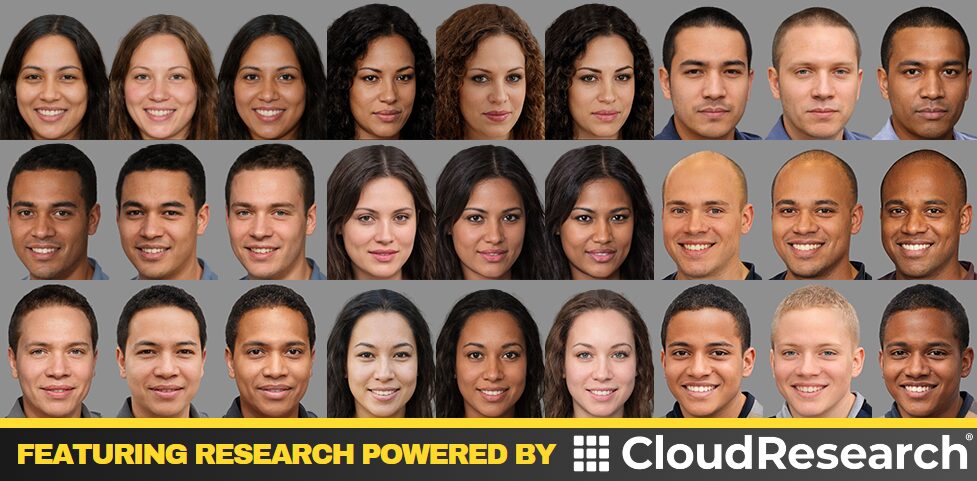The GAN Face Database (GANFD): A Free Database of Face Stimuli with Race/Ethnicity Manipulations for Researchers

Social and cognitive scientists often use images of human faces as stimuli for experimental research. For example, in an influential set of experiments on implicit bias, Payne (2001) presented participants with a face of a Black or White man followed by an image of either a tool or a gun; when participants were required to quickly identify the object, they misidentified tools as guns more often when they followed a Black (vs. a White) face. For studies like this, researchers might use photographs of real faces, as Payne did, or artificial faces (i.e., computer-generated faces or morphs of real faces). The choice of face stimuli depends on the researchers’ needs—specifically, whether they wish to prioritize internal or external validity for their experiment. For example, artificial faces can be easily generated or modified to allow for subtle manipulation of demographics such as race, limiting confounding variables (thus enhancing internal validity), but these faces may not be perceived as real by participants and so the results from these studies may not generalize well to real-world situations (limiting external validity). Alternatively, using photographs of real faces can enhance the generalizability of a study’s results, but images of different people across experimental conditions often introduce confounding variables such as differences in facial structure, expression, or general attractiveness. These characteristics limit the ability of researchers to determine that their intended experimental manipulation led to the changes they observed in their outcome variables (for a more detailed discussion, see Ma et al., 2021).
To help facilitate more controlled but also more generalizable research, my colleagues Ally Jaurique, Mackenzie Ess, Sara Burke, and I have generated and collected norming data for the GAN Face Database (GANFD; manuscript in preparation). We created this database to provide face stimuli that better balance internal and external validity, featuring artificial yet realistic faces that vary in perceived race and ethnicity, including those that are perceived as multi-racial or racially ambiguous. The GANFD stimuli, codebook, and extensive norming data are available to all researchers for free at ganfd.com under the CC BY-NC 4.0 license.
Generating Realistic Face Stimuli with StyleGAN2
To generate our stimulus images, we used StyleGAN2 (Karras et al., 2020), an open-source generative adversarial network developed by Nvidia. StyleGAN2 can be used to generate realistic, high-quality images of faces of people who do not actually exist. We generated tens of thousands of faces through StyleGAN2 then used style mixing to combine the characteristics of these faces, allowing us to subtly modify features such as skin tone and hair texture. This allowed us to change the perceived race or ethnicity of faces within sets while maintaining their underlying structure, pose, and expression. Of the face sets generated, we selected those for the database that we believed would have lower perceived artificiality and that would allow for greater variation in levels of attractiveness, age, and happiness between sets. Images were cropped to the face and backgrounds were replaced with solid grey versions through remove.bg to avoid as many potential confounding variables as possible. Images were also resized to reduce file size.
Testing The Face Stimuli
We tested 296 images through the funding we received from the CloudResearch grant program. We collected norming data through the Connect platform from 1,586 participants who were each presented with 10 faces, one at a time.
Participants rated each face on perceived race/ethnicity, racial prototypicality (i.e., how much they looked like a member of a race), gender, age, attractiveness, and happiness. At the end of the survey, participants saw all 10 faces once again and identified which faces, if any, appeared to be artificial or computer-generated.
The GAN Face Database
Of the 296 faces across 61 sets in the final database, 172 (35 sets) were perceived as male by participants. For race/ethnicity, 15 faces were perceived as Asian, 66 as Black or African American, 25 as Hispanic or Latino, two as Middle Eastern, eight as South Asian, 84 as White or Caucasian, and 96 as being multi-racial or racially ambiguous. Information on how race/ethnicity numbers were determined can be found in the codebook worksheet of the GANFD Excel workbook; also included in this file is a data worksheet with previews of all faces.
Though we sought to limit potential confounding variables during the creation of this database, some characteristics could not be fully controlled through StyleGAN2. For example, there may be unintended differences between images within sets such as slight variations in lighting, clothing color, and hairlines or facial stubble. Despite these limitations, the GANFD provides a large number of realistic face stimuli that will allow researchers to easily manipulate race/ethnicity in their experiments while maintaining a high level of realism for their participants. We believe this database will foster research that contributes to a deeper understanding of how race and racial prototypicality influence human perception and behaviors.
References
Karras, T., Laine, S., Aittala, M., Hellsten, J., Lehtinen, J., & Aila, T. (2020). Analyzing and Improving the Image Quality of StyleGAN. 2020 IEEE/CVF Conference on Computer Vision and Pattern Recognition (CVPR), 8107–8116. https://doi.org/10.1109/CVPR42600.2020.00813
Ma, D. S., Kantner, J., & Wittenbrink, B. (2021). Chicago Face Database: Multiracial expansion. Behavior Research Methods, 53(3), 1289–1300. https://doi.org/10.3758/s13428-020-01482-5
Payne, B. K. (2001). Prejudice and perception: The role of automatic and controlled processes in misperceiving a weapon. Attitudes and Social Cognition, 81(2), 181–192. https://doi.org/10.1037/0022-3514.81.2.181

